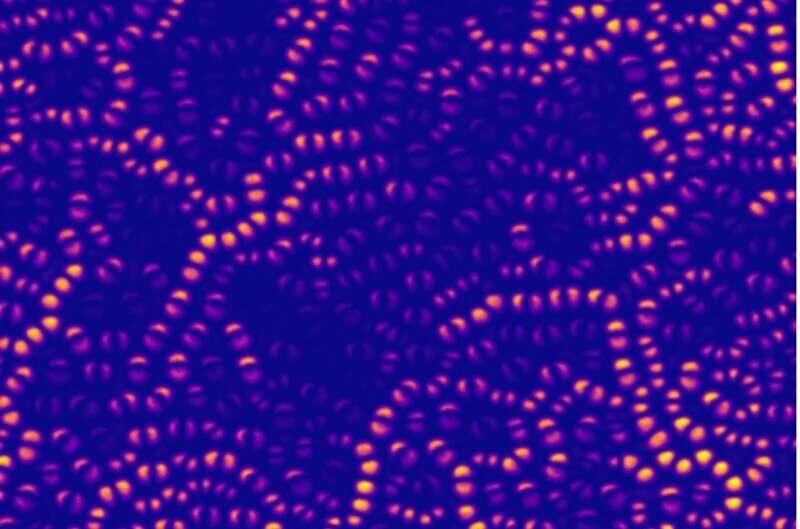Visualization of dynamical heterogeneities in a glassy colloidal suspension, as obtained by difference of optical microscopy images with a lag-time of 25 s. The bright spots correspond to fast-moving particles. Credit: R. Pastore
Glass transition is a Grand Challenge in condensed matter physics and still reveals surprises, despite decades of intense research. For instance, diffusion in glassy liquids was until now thought to be qualitatively similar to that in conventional, "hot" liquids, at least for long observation times. New research published in Physical Review Letters demonstrates that this is not the case: long-time diffusion in glassy liquids is indeed "Fickian yet non-Gaussian" (FnGD), an intriguing feature previously discovered in complex and biological fluids. At variance with those systems, however, FnGD in glassy liquids becomes dramatic when approaching the glass transition and seems to be characterized by universal scaling laws. The study, combining experiments and simulations, was performed by Francesco Rusciano (Ph.D. student), Raffaele Pastore and Francesco Greco at the group of Statistical Mechanics of Soft Materials of the University of Naples Federico II.
The glass-transition issue
After decades of experimental and theoretical efforts by a wide scientific community, the glass transition still remains a major open issue in the fields of condensed matter and complex systems, as shown by the Nobel Prize recently awarded to Giorgio Parisi, one of the leading figure on this topic. But what is a glass? Briefly, when a molecular liquid is rapidly cooled below its melting temperature, crystallization can be avoided. In this state, however, even modest temperature drops make the viscosity increase by orders of magnitude and eventually lead to "glass," a material that is mechanically solid yet maintaining the disordered microscopic structure typical of a liquid. Thus, glass-transition challenges a fundamental assumption in condensed matter, namely that the microscopic structure and the mechanical response of a material are closely related. Interestingly, it has emerged that the glass transition is not a prerogative of molecular liquids only, but it also occurs in other systems, such as colloidal suspensions of increasing concentration. While the development of a comprehensive theory for vitrification is as yet a matter of active debate, it is now clear that an important role is played by the presence of dynamic heterogeneity, i.e., the long-lasting coexistence of clusters of fast- and slow-moving particles. Glassy liquids are in fact considered a paradigmatic model of dynamic heterogeneity.
Fickian non-Gaussian Diffusion
While glass transition is a long-standing issue, FnGD is a much more recent one. Particle diffusion in conventional liquids and in many other systems is characterized by a particle Mean Square Displacement (MSD) increasing linearly in time (Fickian) and by a Gaussian displacement distribution, as predicted by Einstein's celebrated work on Brownian motion and its interpretation in terms of random walk. However, in some systems, like fiber networks or porous materials, diffusion is found to be non-Fickian and non-Gaussian, and is therefore termed "anomalous diffusion." Due to these observations, Fickian and Gaussian behaviors were thought to occur together or not to occur at all.
This common expectation was cracked in 2009 by ground-breaking experiments at Granick's group (University of Urbana, Illinois), revealing the existence of a novel type of diffusion, being simultaneously Fickian but non-Gaussian. Since its discovery in biological fluids, FnGD has been found in a wide variety of soft matter systems, but its understanding still remains elusive. However, the emergence of FnGD is generically associated to some structural or dynamical heterogeneity of the environment where particles move.
Fickian non-Gaussian Diffusion in glassy liquids
The widespread concomitance of heterogeneity and FnGD motivated the researchers at the University of Naples Federico II to search for the possible occurrence of FnGD in glass-forming liquids, the epitome of dynamic heterogeneity, drawing on experiments on colloidal suspensions and simulations of molecular liquids. The study demonstrates that FnGD is not only present in glassy liquids, but it also becomes very marked and long-lasting when approaching the glass transition. The study also shows that universal power-laws capture the relation between the time-scales for onset of Fickianity and for restoring of Gaussianity, as well as the time dependence of the exponential tails of the displacement distributions.
Overall, these findings open the way to a cross-fertilization of ideas between the two issues of FnGD and glass transition. On the one hand, FnGD is the key to understand long-time diffusion in glassy liquids and to revisit well-established concepts, like that of dynamic heterogeneity. On the other hand, the strong signature of FnGD just found in glassy liquids can likely represent a benchmark for future studies of FnGD in other systems.
More information: Francesco Rusciano et al, Fickian Non-Gaussian Diffusion in Glass-Forming Liquids, Physical Review Letters (2022). DOI: 10.1103/PhysRevLett.128.168001
Journal information: Physical Review Letters
Provided by University of Naples Federico II
























